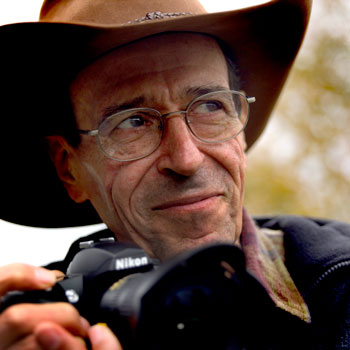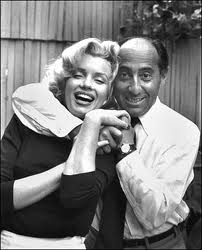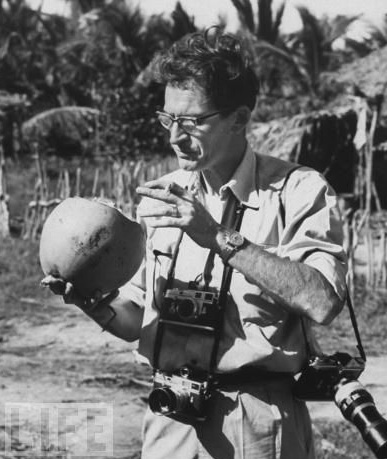Before the internet and the Kindle were invented, generations of Americans saw their lives refracted through the pages of Life magazine. In particular, through its photography, since writers at Life were largely relegated to supplying glorified picture captions. They were also allowed to carry the photographers' equipment.
Obviously the idea of being an object of reverence appeals to photographers. Portrait and fashion snapper Rankin has long admired the work of the great Life lenspersons, and in this film he reviewed their accomplishments and tracked down some of the magazine's fabled survivors. Not that Rankin is the world's greatest TV presenter, frankly. His voice is the sort of nondescript Home Counties drone that American satirists love to parody. As an inquisitor, he looked a bit blank when he found himself face to face with the likes of Burk Uzzle, now retired to small-town North Carolina after a vivid career in which one of many highlights was being assigned to document Hugh Hefner and his voluptuous Playmates at Hef's mansion.
 Luckily, though, most of his subjects were rather awesome characters who had no difficulty in filling the screen unaided (Life photographer Bill Eppridge, pictured right). Indeed, this seemed to be rather the point - a photographer isn't, or shouldn't be, just some geek who knows how to work a camera and programme an array of electronic flashguns. He or she needs to bring empathy, insight, patience and frequently courage to an assignment if they're going to bring back anything that will resonate with readers.
Luckily, though, most of his subjects were rather awesome characters who had no difficulty in filling the screen unaided (Life photographer Bill Eppridge, pictured right). Indeed, this seemed to be rather the point - a photographer isn't, or shouldn't be, just some geek who knows how to work a camera and programme an array of electronic flashguns. He or she needs to bring empathy, insight, patience and frequently courage to an assignment if they're going to bring back anything that will resonate with readers.
Amid a mostly male roll call, Margaret Bourke-White inevitably stood out, not only because she was a fabulous photographer, but also for the way she candidly used her sexuality to gain maximum professional advantage. A highly successful tactic was bedding American generals in order to get priceless wartime scoops. A rival lensman was chastised by Life HQ because she was beating him to the best stories. He cabled back: "Bourke-White has a piece of equipment that I don't have."
 But there were many other stars in the dazzling Life firmament. Alfred Eisenstaedt (pictured left with Marilyn Monroe) was the magazine's grand eminence, and a pioneer of the "candid" style in which he used a Rolleiflex camera held unobtrusively at waist level. W Eugene Smith did pioneering work in the photo-essay genre, gaining extraordinarily intimate access to his subjects in stories like "Career Girl" or "Country Doctor". Rankin noted that "Smith was a tortured genius, Life's Van Gogh." John Loengard shot Marilyn Monroe, The Beatles and the Vietnam War.
But there were many other stars in the dazzling Life firmament. Alfred Eisenstaedt (pictured left with Marilyn Monroe) was the magazine's grand eminence, and a pioneer of the "candid" style in which he used a Rolleiflex camera held unobtrusively at waist level. W Eugene Smith did pioneering work in the photo-essay genre, gaining extraordinarily intimate access to his subjects in stories like "Career Girl" or "Country Doctor". Rankin noted that "Smith was a tortured genius, Life's Van Gogh." John Loengard shot Marilyn Monroe, The Beatles and the Vietnam War.
Life became so singular and influential during the mid-20th century, when 100 million readers would see it every week, that the question inevitably arose of to what extent the magazine was making the news rather than merely recording it. John Shearer's assignments covering the Civil Rights protests in the 1960s became a part of the fabric of social change, as did his astonishing work during the 1971 Attica prison riot. Shearer spent four days inside the jail as a ferocious miniature war raged, leaving 41 men dead.
 Life took a dim view of the Vietnam conflict and ignored demands to tone down its frequently shattering battlefield photographs. British photographer Larry Burrows (seen in clips from a 1969 Omnibus film) talked about his concerns that he was exploiting wartime deaths and suffering, but felt his pictures were justified if they "contribute to the understanding of what others were going through". He was killed in Laos in 1971 (Larry Burrows, pictured right).
Life took a dim view of the Vietnam conflict and ignored demands to tone down its frequently shattering battlefield photographs. British photographer Larry Burrows (seen in clips from a 1969 Omnibus film) talked about his concerns that he was exploiting wartime deaths and suffering, but felt his pictures were justified if they "contribute to the understanding of what others were going through". He was killed in Laos in 1971 (Larry Burrows, pictured right).
Rankin reckoned that it was the arrival of celebrity culture in the 1970s which pulled the carpet out from underneath Life, which published its last issue in December 1972. Celebs were going to rule, and the intimate, deeply researched work that Life had specialised in would become outmoded. Glaswegian snapper Harry Benson, a transplanted Daily Express veteran, was in at the death of Life, and famously became the man who gained access to mad chess genius Bobby Fischer as he played his epic tournament against Boris Spassky in Iceland. The recent documentary Bobby Fischer Against the World gave the impression that Benson had become friendly with Fischer, but the photographer didn't see it that way.
"Everyone knew he was a piece of shit, he was terrible!" he declared. "But it was worth fighting for, to get as close as you can and then get out." He never, ever wanted to become friends with any of his subjects, he added. Photography was apparently no mere popularity contest.















Add comment